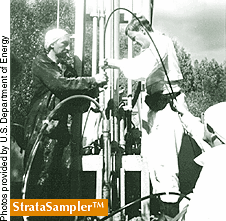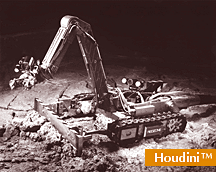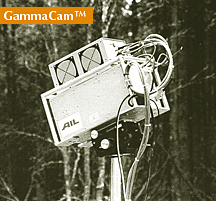
Through agreements between DOE and foreign partners, the Office of Science and Technology’s International Program sponsors the participation of world-class scientists in identifying, evaluating, and demonstrating innovative solutions to environmental problems that plague the United States and other parts of the world. In the previous issue, Initiatives described how OST is using international partnerships to search for environmental technologies to clean up DOE sites. As the following article reveals, the program is also finding foreign markets for OST-developed technologies. The Environmental Management (EM) International Programs works to identify international environmental problems and establish mechanisms for transferring DOE environmental restoration and waste management technologies to the U.S. private sector for commercialization and application in international markets. Success stories are being written in the fields of bioremediation, phytoremediation, subsurface characterization, waste tank remediation, and decontamination and decommissioning. Basing technologies on
natural processes in Poland The project is currently demonstrating innovative approaches to the bioremediation of
petroleum The project is also developing technologies that use plants to remove toxic heavy metals from surface soils. Known as phytoremediation, this technology is a leading candidate for the remediation of large areas of moderately contaminated soils. Southern Poland provides a unique location for the development of phytoremediation. Naturally rich in nonferrous metals and coal, this area has a long history of such contamination. IETU has worked to develop technologies, such as phytoremediation, that can remove this contamination using standard agricultural equipment at relatively low cost. This project has conducted one of the largest-scale deployments of phytoremediation of lead from soils, identified important cost and performance factors, and developed technologies to reduce costs while enhancing performance. This fertile collaboration between DOE, Florida State University, and Polish scientists is producing advanced bioremediation and phytoremediation practices that will have applicability to DOE sites with near-surface organic and/or metal contamination. Potential DOE sites for applying these technologies include Savannah River, Oak Ridge, Fernald, and Brookhaven. These technologies are expected to begin deployment in the United States during FY01. For more information about the Polish initiative, contact Mike Kuperberg, project coordinator for IICER, Florida State University, (850) 644-5516, mkupe@ mailer.fsu.edu. Sampling in Siberia Under the auspices of the Site Characterization and Contaminant Transport Area of the Joint Coordinating Committee for Environmental Restoration and Waste Management, MINATOM and DOE are cooperating in a multiyear project to characterize and model the fate and transport of contaminated groundwater systems. This initiative aims to solve common Russian and U.S. environmental management problems through joint studies that include exchanges and collaborative development of instrumentation, analytical methods, historical data, and computer modeling. A field study was conducted in July 1997 to investigate the migration of contaminated groundwater from Lake Karachay. Since the contaminated groundwater is a relatively dense brine and flows in both porous sediments and the fractured rocks underlying them, model development requires field measurements to characterize the three-dimensional flow and contaminant migration characteristics. The Russian/American field team used a special well-sampling device known as the StrataSampler™ to collect representative water samples from targeted geological layers.
Aided by the StrataSampler, the successful field study yielded important new data to be
used in ongoing modeling work. These data, along with analyses from collected soil cores,
not only help to reveal hydrogeological parameters and sediment properties within the
discharge area of Mishelyak River, but also help validate and verify contaminant migration
models used in the United States. The StrataSampler, now licensed to a commercial
manufacturer, has also been deployed several times at the Savannah River Site. For further
information, see http://www.srs.gov/general/srtech/stcg/ Houdini appears in the United
Kingdom British Nuclear Fuels Ltd. (BNFL) faces this problem in the United Kingdom. BNFL engineers must develop or find reliable technologies to retrieve waste from six tanks at their Sellafield plant, which have been used to store aluminoferric flocs, a by-product of nuclear fuel reprocessing. The tanks, approximately 10 m tall and 15 m in diameter, contain a total of 7,400 cubic meters of sludge and supernatant. All of the sludge material as well as 2-inch piping and a concrete wall must be removed from the bottom of the tanks to enable their decommissioning. The answer may be Houdini™ (OST/TMS ID 2085),
a technology developed in support of Tanks Based on the successful demonstration of the Houdini system in the gunite tanks at Oak Ridge National Laboratory, BNFL engineers decided to try out the system at its mock-up tank facility on the Capenhurst site in Chester, U.K. Houdini’s performance in the April 1998 demonstration led to a collaboration between U.S. and BNFL representatives regarding modifications necessary to optimize Houdini for the unique conditions that exist in the BNFL tanks. Meanwhile, Houdini continues to aid in ORNL tank cleanup. Safe characterization in
Estonia DOE performed a preliminary site characterization of the facility in 1996 as part of
the Paldiski International Expert Reference Group expedition. To do the job, DDFA selected
the GammaCam™ (OST/TMS ID 1840), a tool
demonstrated in the decommissioning of Argonne National Laboratory’s Chicago Pile 5
research reactor, where it successfully imaged radiological spills, isolated radiation
sources in a concrete vault, and detected areas of radiation leakage in temporary
shielding. The system has been repeatedly deployed since then at both DOE and non-DOE
sites (see Initiatives, April 1997, Summer 1998, and Winter
1998 and the ITSR available on OST’s Web site at http://ost.em.doe.gov/ifd/ost/pubs/ Consisting of a portable sensor head that contains a gamma-ray imaging system and a TV camera, the GammaCam displays the relative strength and location of gamma radiation as a two-dimensional image superimposed on the corresponding visual image on a standard portable computer screen located several hundred feet from the radiation area. The sensor’s small footprint and light weight enable easy setup and portability essential for efficient, cost-effective use. Remote operation and control enable safe image acquisition in high-radiation environments, minimizing operator exposure. The PC controls the data acquisition time, field of view, and image display, providing users with the precise locations of radiological sources in an easy-to-use format. During the Paldiski expedition, the GammaCam efficiently localized the key radiological contributors in waste storage cells. With minimal operator exposure, the system operated in a very high-radiation area (greater than 70 rems/hour) and produced images that will be used in the planned site remediation. The location of the radiation sources was verified by Swedish members of the expedition using a gamma spectrometer. It has been recommended that, once these higher radioactive materials are removed, a second image be taken to determine the presence or absence of any lower-level contributors. For more information about the International Program, see its Web site at http://www. |

 hydrocarbon–contaminated soils and has resulted in expedited
contaminant destruction, identification of unique organisms for metabolizing organic
contaminants in low-pH conditions, and application of this technology to other
contaminants and in mobile, on-site treatment systems. The project initially collected and
analyzed data using Expedited Site Characterization (
hydrocarbon–contaminated soils and has resulted in expedited
contaminant destruction, identification of unique organisms for metabolizing organic
contaminants in low-pH conditions, and application of this technology to other
contaminants and in mobile, on-site treatment systems. The project initially collected and
analyzed data using Expedited Site Characterization ( Developed by the Westinghouse Savannah River Company with support
from OST’s Characterization, Monitoring, and Sensor Technology Crosscutting Program,
the StrataSampler collects discrete samples from different depths in a single borehole,
minimizing drilling costs. Isolated sample intervals require no secondary isolation,
reducing the potential for vertical migration of contaminants in the monitoring well.
Typically, the StrataSampler’s simple yet robust design requires no special
installation methods, and the technology is approximately half as expensive as existing
methods. The samplers deployed in Russia were fitted with a docking assembly designed by
MINATOM’s Hydrospetzgeologia to adapt the samplers to Russian pipe and thread.
Developed by the Westinghouse Savannah River Company with support
from OST’s Characterization, Monitoring, and Sensor Technology Crosscutting Program,
the StrataSampler collects discrete samples from different depths in a single borehole,
minimizing drilling costs. Isolated sample intervals require no secondary isolation,
reducing the potential for vertical migration of contaminants in the monitoring well.
Typically, the StrataSampler’s simple yet robust design requires no special
installation methods, and the technology is approximately half as expensive as existing
methods. The samplers deployed in Russia were fitted with a docking assembly designed by
MINATOM’s Hydrospetzgeologia to adapt the samplers to Russian pipe and thread. Focus Area activities at
Fernald in conjunction with EM Industry Programs and the Robotics Crosscutting Technology
Development Program (see Initiatives,
Focus Area activities at
Fernald in conjunction with EM Industry Programs and the Robotics Crosscutting Technology
Development Program (see Initiatives, 